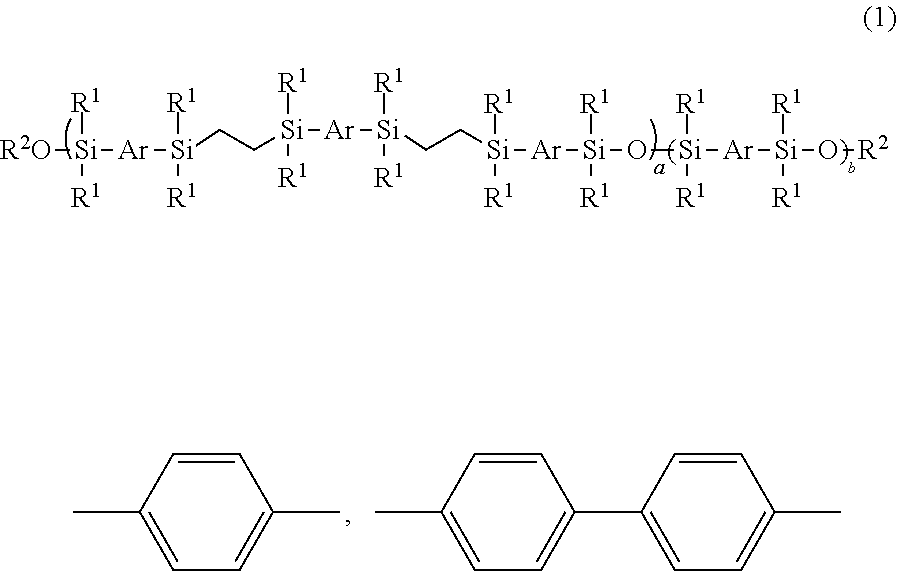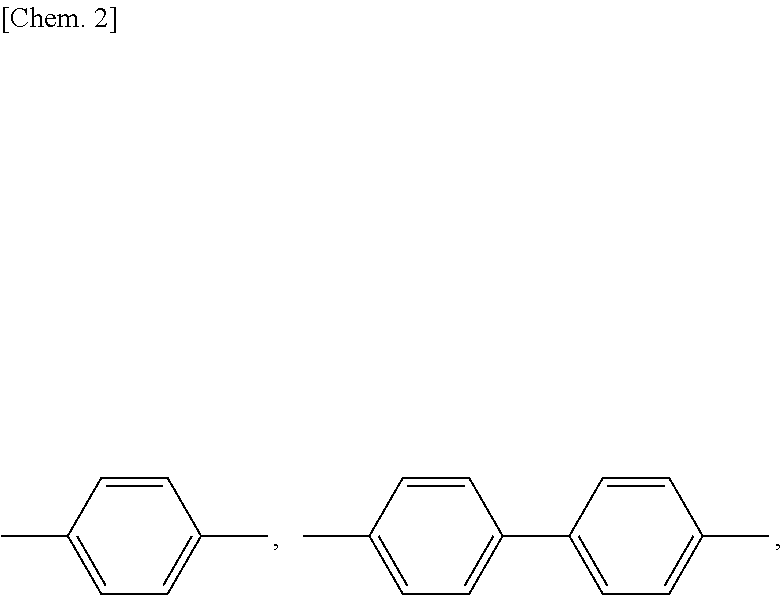Mesogen-silicon compound (co)polymer and thermoplastic elastomer
a thermoplastic elastomer and silicon compound technology, applied in the field of thermoplastic elastomer and thermoplastic elastomer, can solve the problem of difficult to obtain thermoplastic elastomer having rubber physical properties therefrom, and achieve the effect of high transparency, effective moldability and satisfactory rubber physical properties
- Summary
- Abstract
- Description
- Claims
- Application Information
AI Technical Summary
Benefits of technology
Problems solved by technology
Method used
Image
Examples
synthesis example 1
Synthesis of 1,4-bis(hydroxydimethylsilyl)benzene
[0034]A 5 L separable flask equipped with a reflux tube and 1 L dropping funnel was charged with 500 mL of tetrahydrofuran, 2,500 mL of methyl ethyl ketone, 7.8 g of 5 wt % palladium-on-carbon, and 172.8 g of deionized water, and heated at 50° C. Then, the dropping funnel was charged with 757.6 g (3.9 mol) of 1,4-bis(dimethylsilyl)benzene (trade name Silphenylene C by Shin-Etsu Chemical Co., Ltd.), which was added dropwise over 4 hours. After the completion of dropwise addition, the reaction solution was aged for 5 hours. The catalyst was removed by filtration, and the filtrate was concentrated, yielding a white solid. The solid was purified by recrystallization from a solvent mixture of 3 L of hexane and 500 mL of tetrahydrofuran, obtaining 596.9 g (2.6 mol) of 1,4-bis(hydroxydimethylsilyl)benzene (yield 68%).
[0035]1H-NMR (400 MHz, CDCl3) δ 7.61 (s, 4H), 1.95 (brs, 2H), 0.41 (s, 12H)
synthesis example 2
Synthesis of 4,4′-bis(hydroxydimethylsilyl)biphenyl
[0036]A 3 L recovery flask equipped with a reflux tube was charged with 48 g of magnesium, 1 L of dry tetrahydrofuran, and a few droplets of 1,2-dibromoethane, which were heated under reflux in nitrogen atmosphere. Then, 250 g (0.8 mol) of 4,4′-dibromobiphenyl was added to the mixture, which was heated under reflux for 1 hour to prepare a Grignard reagent. The Grignard reagent was transferred dropwise to a 3 L four-necked flask which had been charged with 170 g (1.76 mol) of dimethylchlorosilane and 200 mL of tetrahydrofuran, in an ice bath over 1 hour. After the completion of dropwise addition, reaction was run overnight at room temperature. After the residue was removed by a Kiriyama funnel, the product was purified by distillation at 140-150° C. / 1 mmHg, obtaining 4,4′-bis(dimethylsilyl)biphenyl.
[0037]Like the above procedure for the synthesis of 1,4-bis(hydroxydimethylsilyl)benzene aside from starting with the 4,4′-bis(dimethylsi...
synthesis example 3
Synthesis of Monomer 1
[0038]A 3 L separable flask equipped with a reflux tube and 500 mL dropping funnel was charged with 500 mL of toluene, 1 g of 0.5 wt % toluene solution of Karlstedt catalyst, and 1,165 g (6 mol) of 1,4-bis(dimethylsilyl)benzene (trade name Silphenylene C by Shin-Etsu Chemical Co., Ltd.), which were heated at 80° C. Then, the dropping funnel was charged with 246.5 g (1 mol) of 1,4-bis(vinyldimethylsilyl)benzene (by Shin-Etsu Chemical Co., Ltd.), which was added dropwise over 5 hours. After the completion of dropwise addition, the reaction solution was aged for 24 hours and then allowed to cool down to room temperature. Then 20 g of active carbon was added to the solution, which was stirred for 3 hours, allowing the active carbon to adsorb the residual catalyst. The active carbon was removed by filtration. The filtrate was vacuum distilled at 180° C. and 200 Pa for 4 hours to remove the solvent and unreacted 1,4-bis(dimethylsilyl)benzene, and allowed to cool down...
PUM
| Property | Measurement | Unit |
|---|---|---|
| melting point | aaaaa | aaaaa |
| temperature | aaaaa | aaaaa |
| melting point | aaaaa | aaaaa |
Abstract
Description
Claims
Application Information
 Login to View More
Login to View More - R&D
- Intellectual Property
- Life Sciences
- Materials
- Tech Scout
- Unparalleled Data Quality
- Higher Quality Content
- 60% Fewer Hallucinations
Browse by: Latest US Patents, China's latest patents, Technical Efficacy Thesaurus, Application Domain, Technology Topic, Popular Technical Reports.
© 2025 PatSnap. All rights reserved.Legal|Privacy policy|Modern Slavery Act Transparency Statement|Sitemap|About US| Contact US: help@patsnap.com



